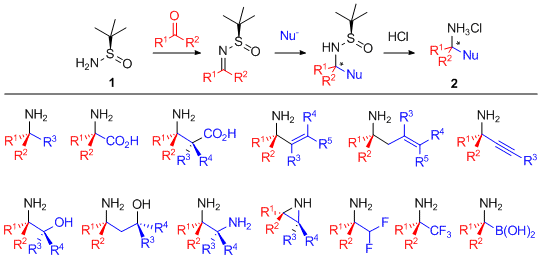More than 80% of all drugs and drug candidates contain amine functionality. Many of these amine-containing compounds are also chiral and can be challenging to prepare. The Ellman lab developed tert-butanesulfinamide 1 as a versatile and extensively used chiral reagent (Figure 1). Over 100 chemical supply companies market 1 with virtually all using the practical two-step catalytic enantioselective route developed for its synthesis by the Ellman lab. Many academic and industrial researchers heavily rely on 1 for the asymmetric synthesis of a large variety of different types of amines 2.

Figure 1. tert-Butanesulfinamide 1 and representative types of amines prepared using this reagent
Chiral reagent 1 has been employed on metric ton scales, and >6000 publications including >3000 patents and patent applications cite its use primarily for the discovery and/or production of drugs, agrochemicals or fine chemicals. In a recent SciFinder sub-structure search of patents, 1 is currently used much more frequently than any other chiral reagent, auxiliary or catalyst. Indeed, 1 has been used for the discovery and/or production of a myraid of clinical candidates and many approved drugs, including Gilead’s recently approved first in class HIV-1 capsid inhibitor lenacapavir, which at only twice yearly administration has shown remarkable effecicacy for the prevention of AIDS and was recognized by Science magazine as the 2024 Breakthrough of the Year.
Sulfinamide functionality has proven to be an essential feature of an increasingly large number of asymmetric catalysts for a range of transformations (Figure 2). The first chiral sulfinamide-based ligand 3 for asymmetric transition metal catalysis was developed in the Ellman lab. We also developed a new class of hydrogen bonding organocatalysts for asymmetric synthesis based upon the sulfinyl group’s unique ability to enhance acidity while at the same time providing a chiral environment. For example, organocatalyst 4 has sole chirality at suifur and enabled the first example of catalytic asymmetric nitronate protonation.

Figure 2. Chiral sulfinamide-based ligands and organocatalysts
The Ellman lab applies the methods and catalysts that it develops to efficient syntheses of bioactive natural products and drug candidates. These include the first total synthesis of the highly potent cytotoxic agent tubulysin D, which is actively being pursued in antibody drug conjugates for targeted chemotherapy, and syntheses of potent and selective cathepsin S inhibitors discovered in the Ellman labs (Figure 3).

Figure 3. Examples of compounds synthesized in the Ellman lab using sulfinamide chemistry
The Ellman lab continues to develop sustainable and highly functional group compatible approaches for the synthesis of diverse classes of amines, including aza-sulfur compounds, from readily available starting materials. In one major new direction, the lab is developing new catalytic reactions, including enantioselective transformations, of N-acyl sulfenamides that proceed by C-S bond formation to provide high oxidation state aza-sulfur compounds. This general class of compounds, as exemplified by sulfilimines and sulfoximines, have become highly valued motifs in drug discovery and development.
